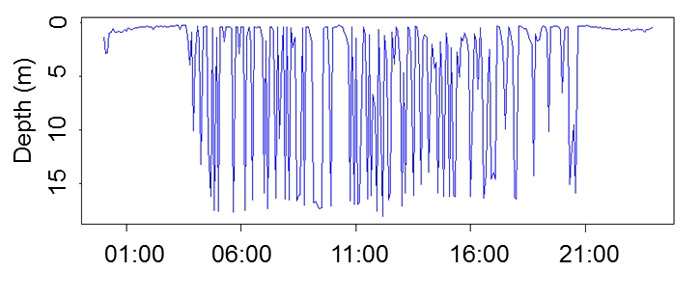What do trout do while at sea in the marine phase of their life? This question has peaked the curiosity of both recreational fishers and scientists for centuries. Now, recent research from DTU Aqua, DK and CEFAS, UK provides new information.
A new peer reviewed publication in Marine Ecology Progress Series reports on the detailed behaviour of sea trout during their marine phase. For anadromous trout, their time at sea represents their main growth period and hence a cardinal period for the long-term success and fitness of sea trout.
The results based on data from sea trout’s tagged with advanced data storage tags reveal a diel behavioural pattern where the trout dive repeatedly to maximum depths of up to 88 metres during daytime, and reside almost permanently at the surface during night time. This pattern has not previously been observed in sea trout, but closely resemblances the behaviour of Atlantic salmon observed in some studies.

Example on a sea trout diving behaviour during a single day. The pattern of diving during daylight hours and the surface orientation during the night is clearly visible in the figure.
In general, the trout were orientated towards the top 3.0 metres of the water column (63.8 % of all measurements), but responded to environmental temperatures. The mean residence depth increased from 1.95 metres when surface temperatures were 5-7oC to 10.1 metres at temperatures above 17oC.
The fish generally maintained body temperatures at 10-16oC during the marine period, which corresponds fairly well with the range reported as optimal for growth (12-17oC). The fish appeared to maintain their body temperatures in this range by residing in areas warmer than the mean for the Danish region during spring. Similarly, they maintained colder body temperatures by residing in colder and deeper waters when water temperatures at the surface increased.
The fish appeared to actively avoid water temperatures above 17 o C by disrupting their characteristic diving behaviour to remain submerged in colder waters at depths of 5-15 metres throughout the day. It remains unknown whether this dramatic change in behaviour occurred to avoid temperatures above 17 o C for metabolic reasons or if the fish adjusted their behaviour as a response to changes in prey abundance or similar.
These findings call for further research in the behaviour of sea trout during their marine migration phase, with a particular focus on the species’ response to sea temperatures.
Advanced data storage tags
The study is based on information from advanced data storage tags. In total, 125 sea trout kelts (length: 460−925 mm) were tagged in Danish rivers between 2012 and 2015. Eight tags, containing detailed measurements of temperature and depth from the entire marine period, were successfully returned to the research team and data from these eight migrants were analysed in depth.
The study was conducted by National Institute of Aquatic Resources (DTU Aqua, Technical University of Denmark, Centre for Environment, Fisheries and Aquaculture Science (UK) and North Highland College at the University of the Highlands and Islands (UK).
The scientific article
Martin Lykke Kristensen, David Righton, Diego del Villar-Guerra, Henrik Baktoft and Kim Aarestrup: Temperature and depth preferences of adult sea trout Salmo trutta during the marine migration phase. Marine Ecology Progress Series 599:209-224 (2018).
Contact: Kim Aarestrup